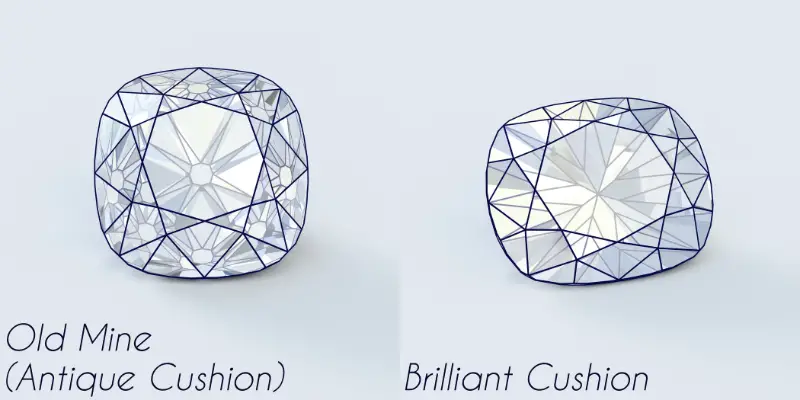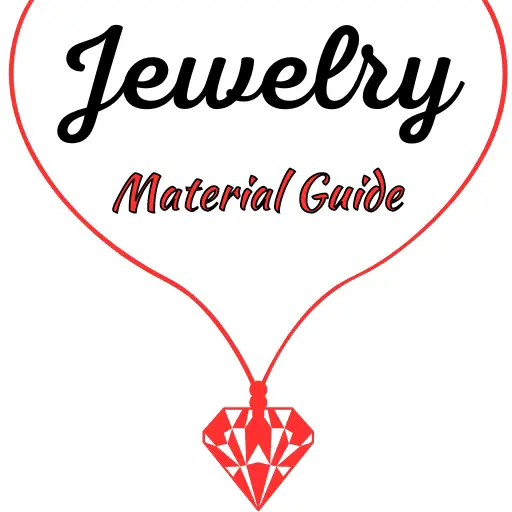Looking into antique diamond cuts ? Then you might be wondering if the old mine cut is the right diamond for you. Wonder no more as today we’re taking a look at this charming diamond and walking you through the basics. Read on !
What is an old mine cut ?
Old mine cut diamonds are a cutting style and shape that was popular in the Georgian and Victorian eras, with a rounded square shape (like a cushion), large wide facets, an open culet, small table, and a very deep cut by today’s standards. The name ‘old mine’ is not new, it was labeled ‘old mine’ even back then. This is because the older mines were in India and Brazil, and this was the typical cut applied to those diamonds. Often you’ll see old mine cut shortened to OMC, just for simplicity’s sake.
Once African diamonds hit the market (the newer mines at the time), the diamonds received a different cut and were often of whiter, clearer quality. The old mine cut referred to diamonds that came from either India or Brazil, with a warm hue and the cut you’ll see explained below.

Old mine cuts are similar to cushion cuts, with an open culet
Old mine cuts were the most likely predecessors of today’s brilliant cushion cuts, albeit with slight changes. The old mine cut has an open culet, a small table, larger, wider facets and a longer pavilion. Overall a much taller or deeper cut diamond than the modern cushion cut, and it interacts with light a little differently too.
Because of this difference in cut and facets, light escapes from an OMC more than it does from modern brilliant cuts. Today you’ll notice this, but back then this was the norm and the whole idea of light leakage was not known. So while in modern times an OMC might look a bit duller, back then it was very impressive.
Read also: Brilliant VS Crushed Ice Cuts
Old mine cuts are warmer diamonds
Let’s explain why and how these old mine cuts were named that way and why they’re usually warmer diamonds. When diamond mining became common, the oldest diamond mines were in India, and then later in Brazil. So people came to know diamonds were primarily from those places. The diamonds found in these mines were of varying quality (color and clarity) and most of them were used, which meant even warmer diamonds and those with some clarity issues were used in jewelry.

Then African diamond mines were discovered, and the diamonds that came from Africa were on average white, clearer, and generally worth a little more. By this time the Indian and Brazil diamonds already had a typical look, which then was named the ‘old mine’ cut, since the India and Brazil mines were older than the African mines.
So keep this in mind when shopping for OMC, they will often be warmer than modern diamonds and may sometimes have more noticeable inclusions.
Most old mine cut diamonds have imperfect symmetry
They are hand cut, so expect some mild proportion issues, like a few facets being larger than others, the diamond being slightly lopsided, or the table misaligned from the culet. This is something that is very difficult to completely avoid when you cut a diamond by hand, as there are no machines to aid you in getting the perfect alignment. All a diamond cutter could do was use his eyes and sense of proportions, and the tools he had at his disposal.
But this all makes OMC diamonds really stand out from modern diamonds. They have little quirks, they are instantly recognizable and they have their own charm or personality.
Old mine cuts are harder to source than other diamonds
Old mine cuts are antique cuts, so there aren’t as many around as there are brilliant or step cut diamonds. This means that whatever diamond you’re buying, it’s very likely to be an actual old, antique diamond that was cut and polished in the early 18th century. Tracking this kind of diamond takes time, so you need to be patient and check your sources when looking for old mine cuts.
That being said, there are diamond cutters who have noticed the growing trend of antique cuts, including the old European cut and the rose cuts. So you may also find some old mine cuts that have been cut in the past 2-3 years, and those can be either a classic antique cut, or a slightly updated and improved upon OMC. Still with an open culet, still with a small table and high pavilion and crown, but with better optics.
Do old mine cut diamonds sparkle ?
Yes, old mine cut diamonds so sparkle but they sparkle less than a round brilliant or a modern cushion brilliant. The reason why is the open culet at the bottom, and the deep cut or the height of the diamond. An open culet leaks light, so the diamond will not be as bright as one with a closed culet. And a tall or deep cut will also angle the light in such a way that the diamond won’t be as bright as a shallower cut.
Overall the OMC diamonds are better at rainbow sparkles (fire), rather than white sparkles (brilliance). And since its facets are cut larger and wider than most brilliant cuts, the result is wider, larger flashes of colored light. For some this can look like moissanite, but in truth it’s just the way the diamond is cut and the way the facets are angled.
If you’d like an old mine cut that sparkle more, you could look for a modern cushion cut, and ensure it has a ratio as close to 1:1 as possible. Normally cushion cuts are 1:1.10 so even a 1:1.03 will be good. Then, you want to have an open culet if you want to get close to the look of an old mine cut.
Are old mine cuts worth more ?
No, old mine cuts are not worth more than modern brilliant cuts since they are usually warmer, more included diamonds, even if they weigh more. Like the old European cut, old mine cuts were cut to maximize carat weight. The price range for old mine cuts is a little lower than the one for typical cushion cuts.

I’m the main author for jewelrymaterialguide.com. I started this site after we did tons of research before our wedding and noticed that there is information about rings, jewelry, and so on that is really hard to find on the internet.






